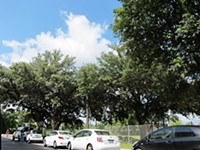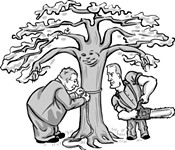Point Austin: The Tree in the Way
Commission decision could lead to changes in ordinance
By Amy Smith, Fri., Oct. 21, 2011

All because of an old pecan tree on Bowie Street. The tree has become the first test case of an ordinance that requires city permission to axe trees that are more than 30 inches in diameter. This one is 32 inches. It's between 60 and 70 years old, stands 57 feet high, and offers a beautiful and surprisingly lush canopy spread of 55 feet. On the city's scale of ranking the health of a tree, arborist Keith Mars has determined that the tree's condition is "good" – the third notch down from "excellent" and "very good."
The Planning Commission spent weeks listening to public testimony and deliberating whether the tree should make way for a Downtown development. On Oct. 11, the panel voted 5-4 to deny the variance that would have allowed the tree's extraction. The tree's intricate root system would not survive a transplant, so moving it was not a viable option.
The Monkey Wrench
Endeavor Real Estate Group is under contract to buy the property in question from landowners Perry Lorenz and Larry Warshaw in order to build an office-residential tower up to 400 feet high. In June, the landowners obtained City Council approval for central urban redevelopment zoning, allowing for additional density, but without considering the tree. A week later, Endeavor submitted paperwork requesting permission to remove two trees. No one disputed axing one of them, which is weather-beaten and decayed, but the other, which has somehow managed to flourish in spite of its asphalt surroundings, has thrown a monkey wrench into the developer's plans.
The property, located in the 300 block of Bowie between Third and Fifth streets, is an ideal spot for a high-rise of mostly residential units. Given the prime location of the nearly 1-acre property and given the presence of a healthy heritage tree on the site, the Planning Commission spent several weeks pondering the "reasonable use" clause in the ordinance – specifically, whether preserving the tree would prevent a "reasonable use" of the land. The answer – ultimately, narrowly – was "no." Sparing the tree, five commissioners argued, wouldn't necessarily negate a dense development on the property.
While some arborists believe the tree would have a 50/50 survival chance as a result of the construction, tree advocates countered that there are regulations for protecting trees during construction and that the project could be designed to accommodate the tree. Indeed, Endeavor presented an alternative plan that included preserving the tree. Downtown resident and urban planning consultant Jim Duncan, who supports keeping the tree, went a step further and showed how that same design could be altered in a way in which the tree would serve as a focal point of the development's main entry.
The decision was especially agonizing for Planning Commission Chair Dave Sullivan, whose vote to deny the variance turned the development community on its ear. Before Oct. 11, Sullivan had been counted as a likely yes vote for the variance. But he explained that he was bound by the "reasonable use" language of the ordinance, and in the same breath stated that the law needs a revision to address such quandaries. "The applicant showed us a plan that would leave the tree there but would only reduce the number of units by 16 percent," Sullivan told me a few days after his vote. "If it had been 50 percent, I would probably agree that [keeping the tree] would deny a reasonable use." Sullivan believes the developers' $70,000 mitigation plan – including planting new trees and $20,000 toward maintenance of heritage trees in nearby Duncan Park – far outweighed the value of a single pecan tree.
If you were to ask me (no one has), I would favor keeping the pecan tree, which carries a great deal of economic value in terms of "ecosystem services." The Texas Forest Service uses that standard in determining the dollar amount that large, older trees contribute in terms of storing carbon, providing shade, preventing storm water runoff, and providing eye appeal.
My opinion aside, the landowners and developers acknowledge they are flummoxed by the Planning Commission's decision. For one thing, the case doesn't move on to City Council, where they would have another opportunity to try to swing the vote. "We honestly haven't yet made any decisions about next steps," said Jamil Alam, a principal with Endeavor. "Regarding the ordinance, it's hard to believe that the intent was to save every existing heritage tree at the expense of any and every other community goal." Alam pointed to the city's recent decision to take down more than two dozen older trees to extend the bike trail along Shoal Creek (Lorenz, et al. donated the Bowie Street property's right-of-way to allow for the trail construction). The city's decision to take out the trees, Alam said, "suggests that even city officials believe it's reasonable to weigh competing community benefits."
Balancing the Trade-Offs
When the case came before the Environmental Board, Lorenz proffered an email he had squeezed out of enviro activist Bill Bunch, the voice of Save Our Springs Alliance. Bunch wrote that he had talked to a few environmental leaders, "and ... there is a recognition that balancing the tradeoffs between preservation and development is shifted in favor of high density, water-, energy-, and traffic-saving development in the central business district that would warrant special exceptions that would not be supported in other parts of town." Bunch added that he wasn't up to speed on this particular case. Asked to amplify this week, Bunch begged off, explaining he was knee-deep in water issues and wasn't the best person to talk to about the tree, anyway.
Meanwhile, informal talk of changing the tree ordinance is starting to gather momentum. Tweaking it to accommodate Downtown development would provide greater financial benefit for landowners and developers. Having to design a project around a tree requires more time and money, and less return on investment. This makes developers unhappy, and when developers are unhappy, laws like the Heritage Tree Ordinance start to come undone.
Got something to say on the subject? Send a letter to the editor.










